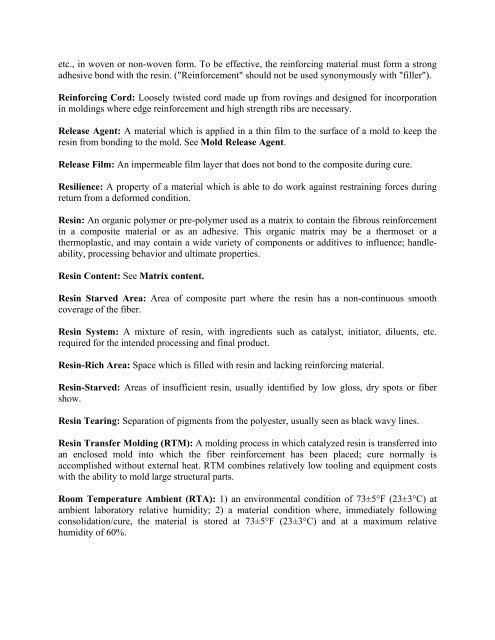Definitions /Dictionary/Glossary - nptel
Definitions /Dictionary/Glossary - nptel
Definitions /Dictionary/Glossary - nptel
Create successful ePaper yourself
Turn your PDF publications into a flip-book with our unique Google optimized e-Paper software.
etc., in woven or non-woven form. To be effective, the reinforcing material must form a strong<br />
adhesive bond with the resin. ("Reinforcement" should not be used synonymously with "filler").<br />
Reinforcing Cord: Loosely twisted cord made up from rovings and designed for incorporation<br />
in moldings where edge reinforcement and high strength ribs are necessary.<br />
Release Agent: A material which is applied in a thin film to the surface of a mold to keep the<br />
resin from bonding to the mold. See Mold Release Agent.<br />
Release Film: An impermeable film layer that does not bond to the composite during cure.<br />
Resilience: A property of a material which is able to do work against restraining forces during<br />
return from a deformed condition.<br />
Resin: An organic polymer or pre-polymer used as a matrix to contain the fibrous reinforcement<br />
in a composite material or as an adhesive. This organic matrix may be a thermoset or a<br />
thermoplastic, and may contain a wide variety of components or additives to influence; handleability,<br />
processing behavior and ultimate properties.<br />
Resin Content: See Matrix content.<br />
Resin Starved Area: Area of composite part where the resin has a non-continuous smooth<br />
coverage of the fiber.<br />
Resin System: A mixture of resin, with ingredients such as catalyst, initiator, diluents, etc.<br />
required for the intended processing and final product.<br />
Resin-Rich Area: Space which is filled with resin and lacking reinforcing material.<br />
Resin-Starved: Areas of insufficient resin, usually identified by low gloss, dry spots or fiber<br />
show.<br />
Resin Tearing: Separation of pigments from the polyester, usually seen as black wavy lines.<br />
Resin Transfer Molding (RTM): A molding process in which catalyzed resin is transferred into<br />
an enclosed mold into which the fiber reinforcement has been placed; cure normally is<br />
accomplished without external heat. RTM combines relatively low tooling and equipment costs<br />
with the ability to mold large structural parts.<br />
Room Temperature Ambient (RTA): 1) an environmental condition of 73±5°F (23±3°C) at<br />
ambient laboratory relative humidity; 2) a material condition where, immediately following<br />
consolidation/cure, the material is stored at 73±5°F (23±3°C) and at a maximum relative<br />
humidity of 60%.
















